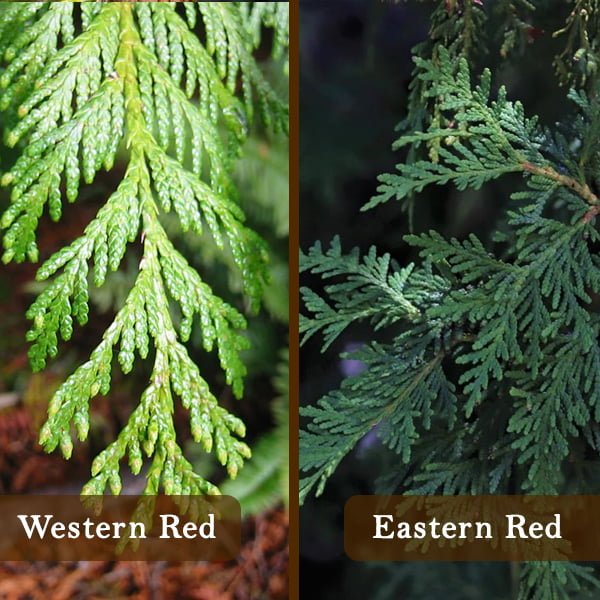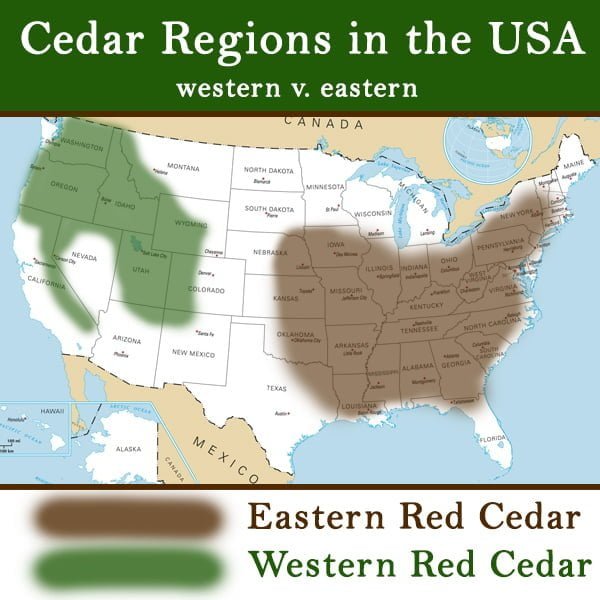When planning your next project, do you often wonder the difference between western red cedar vs eastern red cedar? Fear not! We’re here to slice through the confusion with a dose of humor and heaps of helpful insights.
Today, we’re tackling the age-old debate: Western Red Cedar versus Eastern Red Cedar. By the end of this, you won’t just be an informed reader; you’ll be the savvy cedar selector your neighbors envy.
So, buckle up as we delve into the world of “western red cedar vs red cedar” and discover how you emerge as the real winner with the right cedar for your needs.

Meet the Cedars
First up, let’s introduce the contenders in our great cedar standoff.
Western Red Cedar (Thuja plicata)
From the rain-soaked forests of the Pacific Northwest comes this gentle giant. Known for its impressive stature and welcoming branches, it’s the cedar that keeps on giving.
Eastern Red Cedar (Juniperus virginiana)
From the vibrant fields of the East Coast to the rugged central plains, this tough contender thrives where others might falter. It’s the underdog with a punch of durability.
What Sets Them Apart?
Distinguishing these cedars goes beyond their charming looks. It’s about their unique characteristics that fit different needs.
Appearance and Texture
Western Red Cedar: Sports a fine grain and a smooth texture, making it perfect for those who appreciate a subtle charm that ages gracefully.
Eastern Red Cedar: Offers a denser, more knotty look, exuding a robust character that’s as strong as it is aromatic.

Performance and Durability
Let’s see how these cedars perform when the chips are down (or sawn).
Usage and Longevity
Western Red Cedar: Its natural resistance to decay makes it ideal for exterior applications like siding and roofing.
Eastern Red Cedar: With its inherent toughness, it excels in products that require durability like fence posts and furniture.
Aroma and Ambiance
Western Red Cedar: Its subtle fragrance adds a hint of the forest to any space. This makes Western Red Cedar a great us for saunas in the United States.
Eastern Red Cedar: Known for its potent scent, it keeps moths away and freshness in. This is the reason why so many people build their closet out of Eastern Red Cedar.

Geographical Footprints
Where do these cedars call home in the vast American landscape?
Western Red Cedar
Found in: Primarily thrives in the moist, temperate rainforests of the Pacific Northwest.
Climate Preference: Prefers the cool, damp conditions of coastal regions.
Eastern Red Cedar
Found in: Spreads widely across the East Coast and the Central United States.
Climate Preference: Adapts well to a variety of climates, from humid eastern shores to dry central plains.

Product Showdown
Which cedar brings more to the table in terms of product versatility?
Western Red Cedar Products
Common Products: Shingles, siding, outdoor furniture, boxes, and high-end exterior finishes.
Specialty Uses: Also favored for boat building due to its lightweight and rot-resistant nature.
Eastern Red Cedar Products
Common Products: Closet linings, cedar chests, rings, balls, hang-ups, and essential oils.
Specialty Uses: Often used for pencils and small wooden crafts due to its fine grain and workability.
Explore detailed profiles of cedar products.
DIY projects to maximize the use of each cedar type.
Who Is The Ultimate Winner In The Battle Of Western Red Cedar Vs Eastern Red Cedar?
YOU ARE!
Armed with knowledge about the appearance, performance, geographic distribution, and product offerings of Western and Eastern Red Cedar, you’re well-prepared to make an informed choice for your next project.
Whether it’s the weather-resistant Western cedar or the robust Eastern variety, each has its charm and utility.
Conclusion
Both Western and Eastern Red Cedar have unique qualities that make them valuable for different applications. Your project’s needs and the specific characteristics of each wood type will guide your choice, ensuring that you pick the perfect cedar every time.
Cedar Sense Has The BEST Cedar Available!
Whether it be our Cedar Boxes, Cedar Oil, or Cedar Blocks, Cedar Sense’s cedar is the best you’ll find on the market today!
 Barrel Saunas
Barrel Saunas



